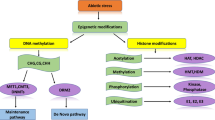Abstract
TRIMETHYLAMINE is known to accumulate in the sexual organs of many plants and animals1. Its action as an aphrodisiac has also been observed. Some connexion of trimethylamine with sex hormones appeared therefore possible. On the other hand, the effects of animal sex hormones on flowering2 and on the development of 'phytocarcinomata'3 having been demonstrated, a further association of ideas concerning the possibility of similar parallelisms of action of trimethylamine did not seem to be too farfetched.
Similar content being viewed by others
References
Czapek, Fr., "Biochemie des Pflanzen" (Fischer, 3rd ed., 1925).
Schoeller, G., and Goebel, H., Biochem. Z., 278, 298 (1935).
Havas, L., NATURE, 136, 516 (1935).
Havas, L., Bull. du Cancer, 26, No. 6 (Dec. 1937).
Beaune, A., Bull. Sci. pharmacol., 42, 193 (1935).
Author information
Authors and Affiliations
Rights and permissions
About this article
Cite this article
HAVAS, L. Effects of Trimethylamine in Plants and Animals suggestive of Hormonal Influence. Nature 142, 752–753 (1938). https://doi.org/10.1038/142752a0
Issue Date:
DOI: https://doi.org/10.1038/142752a0
- Springer Nature Limited
This article is cited by
-
Trimethylamine in Menstruous Women
Nature (1938)





